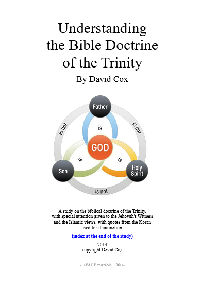Peake, Arthur S. – Commentary on the Bible
Peake, Arthur S. – Commentary on the Bible
Peake’s Commentary, first published in 1919 as A Commentary on the Bible, was written by 61 authors and edited by Arthur Samuel Peake. A few of the others authors include George G. Findlay, Samuel Holmes, and James Moffatt.
In 1937, Peake’s Commentary was republished with a 40 page supplement, edited by A. J. Grieve. Between 1939 and 1960, the work was republished 10 more times.
(Note on the 1937 version vs. the 1962 version: In 1962 Matthew Black and Harold Henry Rowley rewrote Peake’s Commentary. But this theWord module is the 1937 edition edited by Peake, not the 1962 rewritten version).
Peake’s one volume commentary covers the entire Bible, with an emphasis on biblical criticism, interpretation, history and theology from the nineteenth century.

Cox A Study on the Trinity is a short 32-page work on the Trinity with special attention applied towards Muslims and Jehovah's Witnesses. Chapters: 1. God is One Monotheism. | 2. Why God is one, but has to be three persons in that one God: Love needs three people. | 3. Other Consideration that God has to be three persons. | 4. God the Father is God | 5. Jesus is God | 6. The Holy Spirit is God. | 7. Unacceptable explanations of the Trinity. | 8 Conclusion. Alternate Download Site: Christian-kindle-library.com
The 40 page supplement edited by A. J. Grieve is included in the Book module. Topics include “The Language of the New Testament,” “The Roman Empire in the First Century,” “The Holy Land,” “Weights, Measures, Money, and Time,” “Contemporary Jewish Religion,” and many more. Download “Peake, Arthur S. - Commentary on the Bible” Peake-Arthur-S.-Commentary-on-the-Bible.cmt.twm – Downloaded 214 times – 6.21 MB
Advertisement
Using theWord Module layout Sets theWord does not just read the particular modules (books) you have in its folder. These books must be registered and added to a "Module Layout Set", which one of these must be chosen. So you can separate, slice and dice your library as you wish, or put them all into a single library. But the module may be invisible if you do not correctly set this up on adding a new module. This class explains all of how to do this.